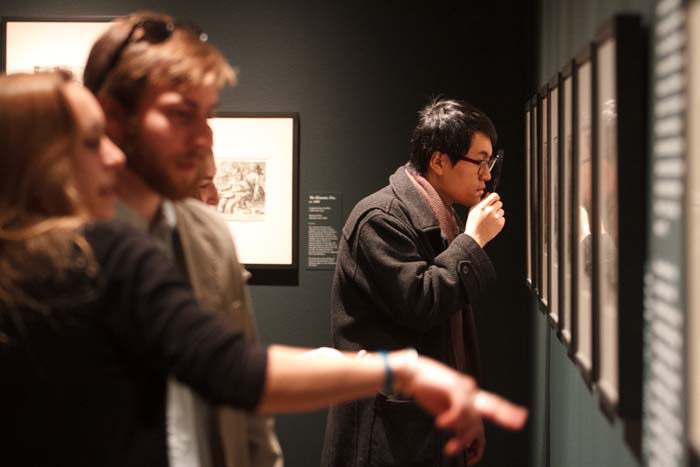Letters & Lines

Attendees examine the finely detailed prints featured in the student-curated exhibition Letters and Lines. Photo by Carl Socolow '77.
Student-curated exhibit highlights interplay between image and text
by MaryAlice Bitts-Jackson
In Hendrik Goltzius's 1588 engraving, Apollo stands, naked and magnificent, atop a pillar of clouds, one foot forward, one finger pointed heavenward. Above his head we see a halo of script that describes a “radiant sun” and “red hair, flashing,” which “dispel the darkness” and “enlighten the world.” Both illustration and text paint a glittering portrait of the sun god, but presented together, they pack a double punch.
That combustible combination is the inspiration behind this year's senior-curated exhibition, Letters & Lines. Presented by class of 2014 members Dana Angotta, Victora Cote, Chloe Cunningham, Taylor Evertsberg, Diamond McClintock, Victoria Schonfeld, Benjamin Slyngstad and Lauren Wyman, the exhibition showcases Renaissance prints from France, Germany and the Netherlands chosen from a collection on loan to The Trout Gallery. It opened Friday, Feb. 21 and continues through April 12.
A requirement for all senior art-history majors at Dickinson, the annual student-curated exhibition represents the culmination of all that the students have learned as undergraduates. As co-curators, they work together to identify the exhibit theme, select the works they will show and design all aspects of the event production, from paint color to layout. They also hang the show, contribute original research to the exhibition catalog and preside over the opening-night reception.
This high-level experience gives Dickinson's future curators and art historians a chance to practice the skills of their trade in a professional setting, much as the college's senior studio-art majors design an exhibit of original works, science majors present research at symposia and music majors perform recitals. The fact that they get to do so together is the icing on the cake, Cunningham says.
“In art history, we don't get many opportunities to work as part of a group,” she explains, pinpointing a luxury rarely afforded to art historians, artists, writers and many academics. “It's valuable experience to have, because it's much more reflective of [most workplaces].'”
"We all enjoyed ourselves, and we became better team players," McClintock agrees. "I loved the entire experience."
Related stories and resources:
Articulating an American Aesthetic
Published February 28, 2014